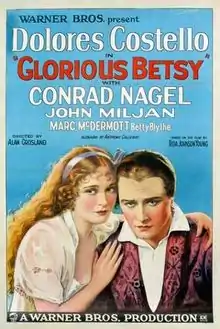Glorious Betsy
Glorious Betsy is a 1928 silent film with talking sequences. It is based on the 1908 play of the same name by Rida Johnson Young, and it stars Dolores Costello. It was produced by Warner Bros. and nominated for an Academy Award for Best Writing, Adaptation in 1929. The film was directed by Alan Crosland with cinematography by Hal Mohr.[2] A mute print of this film survives in the Library of Congress, and while the copy is missing some of the sound reels, it's unknown whether other copies of the sound have been preserved elsewhere.[3][4][5][6][7][8] Vitaphone track survive incomplete at UCLA Film and Television Archive.
| Glorious Betsy | |
|---|---|
 1928 theatrical poster | |
| Directed by | |
| Screenplay by |
|
| Based on | Glorious Betsy by Rida Johnson Young |
| Starring | |
| Cinematography | Hal Mohr |
| Edited by | Thomas Pratt |
Production company | |
| Distributed by | Warner Bros. Pictures |
Release date |
|
Running time | 80 minutes (7-8 reels; 7,091 feet) |
| Country | United States |
| Language | Silent film (English intertitles & talking sequences) |
| Budget | $198,000[1] |
| Box office | $965,000[1] |
Although the film was written by both Anthony Coldeway and Jack Jarmuth (the latter credited only for title cards); only Coldeway was nominated for the Academy Award.
Plot
The film is a semi-historical narrative and depicts the real-life courtship, marriage, and forced breakup of Jérôme Bonaparte, brother of Napoleon, and his wife from the American South, Elizabeth Patterson. Napoleon did not approve of the union (despite the fact that her family was one of the wealthiest in America), and the marriage was annulled. Jérôme was subsequently forced to marry Catharina of Württemberg. They had one child, depicted in the film, Jérôme Napoleon Bonaparte. In order to provide a "happy ending", Jérôme in the film leaves France to be with his wife. However, in historical fact he remained in Europe.
Production
The film is based on the 1908 Broadway play written by Rida Johnson Young and starring Mary Mannering. It was produced by Lee and Jake Shubert, and opened at the Lyric Theatre on September 7, 1908. It only ran 24 performances and closed in September 1908. Future film players Charles Clary, Harrison Ford, and Maude Turner Gordon had roles in the production.[9]
Cast
- Dolores Costello as Betsy Patterson
- Conrad Nagel as Jérôme Bonaparte
- John Miljan as Preston
- Marc McDermott as Colonel Patterson
- Pasquale Amato as Napoleon Bonaparte
- Michael Vavitch as Capt. St. Pierre
- Andrés de Segurola as Capt. Du Fresne
- Paul Panzer as The Ship's Captain
- Clarissa Selwynne as Aunt Mary
- Betty Blythe as Princess Frederick
Premiere Vitaphone short films
Glorious Betsy premiered at Warners Theatre in New York City on April 26, 1928.
| Title | Year |
|---|---|
| Marion Talley, Soprano, and Beniamino Gigli, Tenor, of the Metropolitan Opera Company, Singing "Verranno a te sull'aura" (Borne on the Sighing Breeze) from Act 1 of Lucia di Lammermoor | 1927 |
Box office
According to Warner Bros records the film earned $815,000 domestically and $153,000 foreign.[1]
See also
- List of early Warner Bros. talking features
References
- Warner Bros financial information in The William Shaefer Ledger. See Appendix 1, Historical Journal of Film, Radio and Television, (1995) 15:sup1, 1-31 p 6 DOI: 10.1080/01439689508604551
- "The 1st Academy Awards (1929) Nominees and Winners". Academy of Motion Pictures Arts and Sciences. Retrieved May 19, 2019.
- Glorious Betsy at silentera.com database
- The American Film Institute Catalog Feature Films: 1921-30 by The American Film Institute, c. 1971
- The AFI Catalog of Feature Films:Glorious Betsy
- Catalog of Holdings The American Film Institute Collection and The United Artist Collection at The Library of Congress by The American Film Institute, c.1978
- The Library of Congress American Silent Feature Film Survival Catalog: Glorious Betsy
- 1957 MOVIES FROM AAP Warner Bros Features & Cartoons SALES BOOK DIRECTED AT TV
- Glorious Betsy, a play, at the Lyric Theatre New York 1908
